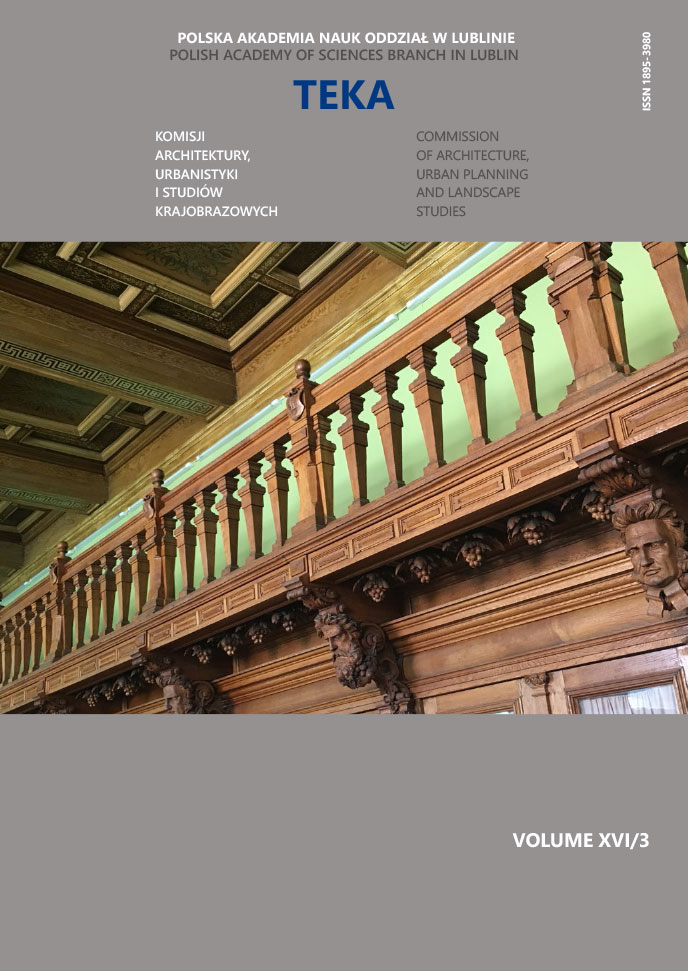Surveing housing districts of Lublin: building types and energy performance
Article Sidebar
Open full text
Issue Vol. 16 No. 3 (2020)
-
Residential districts of the socialist realism period in Poland (1949−1956). Analysis, comparison and protection
Zuzanna Napieralska, Elżbieta Przesmycka7-18
-
Architecture of Polish water sports facilities located in parks in the interwar period
Wojciech Kocki19-23
-
The Truth in Architecture as a Synthesis of Material and Ideas – Brick Architecture of Białystok
Andrzej Tokajuk24-32
-
Adaptation and embedding of modern military objects on the example of the Kłodzko Fortress
Katarzyna Drobek33-41
-
Comparative method with the use of laser scanning as a starting point for the assessment of the state of preservation of the face of the walls in the Kłodzko Fortress
Piotr Gleń, Karol Krupa42-49
-
Architecture in the public space – streets and squares under the conditions of urban globalization
Dariusz Gaweł50-57
-
Surveing housing districts of Lublin: building types and energy performance
Anna Ostańska58-65
-
Architectural Methods of Protecting the Existing Trees in the City. Case Study
Wojciech Jabłoński66-73
-
Selected determinants of multi-family housing in Katowice in the 2030 perspective
Beata Komar74-83
-
Adaptation of form based code method in the Polish spatial planning system
Bartosz Kaźmierczak84-92
Archives
-
Vol. 18 No. 4
2022-12-30 5
-
Vol. 18 No. 3
2022-12-27 5
-
Vol. 18 No. 2
2022-12-27 5
-
Vol. 18 No. 1
2022-12-27 4
-
Vol. 17 No. 4
2021-12-30 11
-
Vol. 17 No. 3
2021-12-30 9
-
Vol. 17 No. 2
2021-12-30 8
-
Vol. 17 No. 1
2021-12-30 8
-
Vol. 16 No. 4
2020-12-30 11
-
Vol. 16 No. 3
2020-09-30 10
-
Vol. 16 No. 2
2020-06-30 11
-
Vol. 16 No. 1
2020-03-31 10
-
Vol. 15 No. 4
2019-12-30 6
-
Vol. 15 No. 3
2019-10-31 9
-
Vol. 15 No. 2
2019-06-28 12
-
Vol. 15 No. 1
2019-03-29 13
-
Vol. 14 No. 3
2018-10-28 14
-
Vol. 14 No. 2
2018-06-29 14
-
Vol. 14 No. 1
2018-03-30 13
Main Article Content
DOI
Authors
Abstract
The paper presents a survey on energy efficiency of the housing stock of the city of Lublin. The following criteria were adopted for the examination of selected estates: age of buildings, ownership structure, construction methods, and type of heat source. Results of energy audits of representative buildings were extrapolated to assess whole housing areas.
Keywords:
References
Rozporządzenie Ministra Infrastruktury z dnia 17 marca 2009 r. w sprawie szczegółowego zakresu i form audytu energetycznego oraz części audytu remontowego, wzoru kart audytów.
Rozporządzenie Ministra Transportu, Budownictwa i Gospodarki Morskiej z dnia 6 listopada 2012 r. zmieniające rozporządzenie w sprawie warunków technicznych, jakim powinny odpowiadać budynki i ich usytuowanie.
Skala podana przez WACETOB, Warszawa, wrzesień 2001 r., cytowaną w: Podejście kosztowe w wycenie nieruchomości: Metodologia; Zużycie obiektów; Przykłady, WAECTOB, Warszawa 2010, s. 19.
KB – karty danych budynku załączono w Zestawieniu zbiorczym danych inwentaryzacyjnych budynków w Lublinie – maszynopis autorki.
KEB – karty danych energetycznych załączono w Zestawieniu zbiorczym danych audytowych budynków w Lublinie, wraz z aktualnymi termogramami – maszynopis autorki.
Article Details
Abstract views: 245
License

This work is licensed under a Creative Commons Attribution-ShareAlike 4.0 International License.


